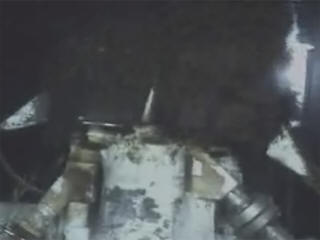|
Latest News:
29/06/10
- BP Says Oil Spill Cleanup
Operation May Be Delayed as Storm
Strengthens
BP Plc
said its efforts to contain the
largest oil spill in U.S. history in
the Gulf of Mexico may be disrupted
as Tropical Storm Alex strengthens.
Alex, the first named system of this
year’s Atlantic hurricane season,
has already forced the evacuation of
some offshore rigs in the Gulf. BP
has been collecting gushing oil from
the Macondo well through two systems
feeding crude to the Discoverer
Enterprise and the Q4000 drilling
rig, with a capacity of as much as
28,000 barrels a day.
Full article
28/06/10
- BP oil spill costs reach $2.65bn
BP has
said the cost of cleaning up the oil
leak in the Gulf of Mexico has now
reached $2.65bn (£1.76bn). The oil
giant said this included the cost of
the spill response, containment,
relief well drilling, grants to Gulf
states and claims paid.
The total has risen to an average of
$100,000 a day over the past three
days - the highest daily average so
far. The company said more than
39,000 people were now involved in
the response effort. More than
80,000 claims had been submitted, BP
said, and it had made 41,000
payments totalling more than $128m.
BP added it was too early to
quantify other potential costs and
liabilities arising from the
incident.
Full article
24/06/10
- Pensacola Beach Covered in Tar
Balls
Pensacola Beach, Fla. - Along at
least eight miles of this part of
the Florida coast, tar balls from
the Gulf oil spill washed ashore
Tuesday night.
"My friends went swimming last night
and came out covered in oil," says
Heidi Grace, a visitor from New
Orleans. "I cried. It's
heartbreaking."
This is most likely the largest
beach fall of oil yet along one of
America's most popular vacation
destinations. The scene could repeat
itself in the coming days, petroleum
experts say.
Full article
24/06/10
BP refits Gulf of Mexico oil cap
after accident
BP
says it has reinstalled a
containment cap on its blown-out
well in the Gulf of Mexico after an
accident unleashed a torrent of oil.
BP was forced to remove the cap
after an underwater robot bumped
into the venting system.
Gas had risen through the vent that
carried warm water down to prevent
ice-like crystals from forming in
the cap.
The cap has been partially
containing the leaking oil and
directing some of it to a surface
ship.
The decision to remove the cap for
repairs meant that oil was flowing
unhindered into the ocean for about
10 hours on Wednesday.
Full article
21/06/10
BP 'estimated higher oil amount'
from Gulf well leak
A BP document has revealed the
company estimated that 100,000
barrels of oil a day could, in
theory, flow from the ruptured Gulf
of Mexico well.
That amount, included in an undated
internal document released by US
Congressman Ed Markey, is nearly
twice the current US estimate of the
leak.
BP says the 100,000 figure is not
relevant as it is not based on
reality.
US lawmakers have repeatedly accused
BP of not being straightforward
about the true size of the spill.
Full
article
Location Information:
The
Deepwater Horizon oil spill (also
referred to as the BP oil spill, the
Gulf of Mexico oil spill, the BP oil
disaster or the Macondo blowout) is
a massive ongoing oil spill in the
Gulf of Mexico, now considered the
largest offshore spill in U.S.
history Some estimates placed it by
late May or early June, 2010, as
among the largest oil spills in the
world with tens of millions of
gallons spilled to date. The spill
stems from a sea floor oil gusher
that resulted from the April 20,
2010 Deepwater Horizon drilling rig
explosion. The explosion killed 11
platform workers and injured 17
others.
T he
gusher, now estimated by the
quasi-official Flow Rate Technical
Group to be flowing at 35,000 to
60,000 barrels (1,500,000 to
2,500,000 US gallons; 5,600 to 9,500
cubic metres) of crude oil per day,
originates from a deepwater wellhead
5,000 feet (1,500 m) below the ocean
surface. The exact spill flow rate
is uncertain due to the difficulty
of installing measurement devices at
that depth and is a matter of
ongoing debate. The resulting oil
slick covers a surface area of at
least 2,500 square miles (6,500
km2), with the exact size and
location of the slick fluctuating
from day to day depending on weather
conditions. Scientists have also
reported immense underwater plumes
of oil not visible at the surface. he
gusher, now estimated by the
quasi-official Flow Rate Technical
Group to be flowing at 35,000 to
60,000 barrels (1,500,000 to
2,500,000 US gallons; 5,600 to 9,500
cubic metres) of crude oil per day,
originates from a deepwater wellhead
5,000 feet (1,500 m) below the ocean
surface. The exact spill flow rate
is uncertain due to the difficulty
of installing measurement devices at
that depth and is a matter of
ongoing debate. The resulting oil
slick covers a surface area of at
least 2,500 square miles (6,500
km2), with the exact size and
location of the slick fluctuating
from day to day depending on weather
conditions. Scientists have also
reported immense underwater plumes
of oil not visible at the surface.
Experts fear that the spill will
result in an environmental disaster,
with extensive impact already on
marine and wildlife habitats. The
spill has also damaged the Gulf of
Mexico fishing and tourism
industries. There have been a
variety of ongoing efforts to stem
the flow of oil at the wellhead.
Crews have been working to protect
hundreds of miles of beaches,
wetlands and estuaries along the
northern Gulf coast, using skimmer
ships, floating containment booms,
anchored barriers, and sand-filled
barricades along shorelines. The
U.S. Government has named BP as the
responsible party in the incident,
and officials have said the company
will be held accountable for all
cleanup costs resulting from the oil
spill
Local
Weather:
|